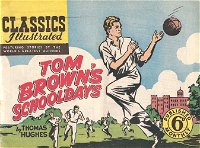Ayers & James by James Zee
Introducing Ayers & James
The Australian run of Classics Illustrated, commencing in 1947, is Ayers & James most enduring and famous comics legacy, although the company is associated with thousands of comics from the 1940s until the 1970s.11Since this article in 2011 proposed that Ayers & James later became Magazine Management, I've confirmed that the two were...
Most of this publishing output is disguised behind diverse trading names or successors—such as Red Circle Press, Illustrated Publications, Approved Publications and others—all associated with the later Magazine Management company.
Ayers & James only gradually transitioned into comics publishing. The company was founded some time before 1916,22For an interesting historical view of Ayers & James, see the City of Sydney Archives collection item SRC14555. Dated... operating initially as an importer33In 1916, Ayers & James Pty. Ltd. was listed as part of a customs inquiry into "Contravention sec. 37 Beer... of diverse consumer products from the United States.44A newspaper advertisement in May 1917 (SMH 5/5/1917) calls for "Australian Manufacturers Requiring Supplies of raw materials from America...
By the 1930s, Ayers & James was distributing 250,000 copies each month of magazines from Macfadden Publications (New York), a founder of the new genre of "true confessions" magazines. Macfadden launched True Story in 1919, followed by other well-known magazines such as True Detective, True Experiences and True Romances.55See The Courier-Mail 9/2/1937. In February 1937, Mr. J. E. Williamson, export manager for Macfadden Publications arrived in Australia...
In August 1938, Ayers and James director, Mr CP Ayers,66Ayers and James was a family company. A Harold Ayers (and Clarence Sivier) from the company were reported attending a... argued against an Australian ban on those periodicals as it discriminated against American publications, while comparable UK publications continued to be available in Australia.77SMH 26/8/1938: "Mr Ayers said that no English publications had been banned although it was impossible to differentiate between... The following month, the US company's public relations counsel, Mrs. E. Lumsden, arrived in Sydney to continue the argument that the magazines were not morally offensive.88SMH 26/9/1938, MAGAZINE BAN. Macfadden Publications. Woman Executive Seeks Lifting. "Mrs. E. Lumsden, public relations counsel throughout the world...
It seems the appeal was briefly successful. However, in April 1940 imports of virtually all US magazines, including Facfadden magazines, were banned under war time credit control regulations.99SMH 12/4/40.... With foreign publications increasingly restricted during the war years, it seems Ayers & James saw an opportunity to be part of the burgeoning local industry.
Among Ayers & James' earliest publications (dating from around 1939 or 1940) were children's picture and activity books, including reprints of Walt Disney Picture Books1010These could date to the late 1930s if Australian editions were published soon after their US counterparts. The Whitman Snow... and Little Golden Books.1111Children's Classics report the first batch of 12 different US Little Golden Books were published 1 October 1942.... The Australian Little Golden Book reprints did not include the US series brand and the distinctive spine binding was just printed on the cover. Ayers and James continued to publish children's books until at least 1951.
Throughout the 1940s, Ayers & James also published reprints of pulp western stories in magazines with titles such as Gunpowder Westerns, Wild West Stories, Prairie Westerns, Action Packed Westerns and Gun Packed Westerns. These drew on the output of US companies such as Magazine Publishers (Western Trails, Western Aces) and Street & Smith Publications (Western Story, Wild West Weekly).1212For some of these, see The Douglas Taylor Collection of Australian Pulps and Paperbacks at the University of Melbourne....
Ayers and James introduced its first comics sometime soon after 1940.



